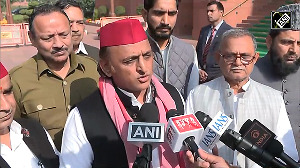 Infosys Technologies's upbeat guidance for FY05 has made analysts sit up and take notice. In an interview with The Smart Investor, Nandan Nilekani, chief executive and managing director of Infosys Technologies, talks about various issues like rupee appreciation and withdrawal of tax benefits for the sector while looking ahead at focus areas and key growth drivers. He also addresses the operating and competitive dynamics of the rapidly evolving company and talks about opportunities in India and abroad.
Infosys Technologies's upbeat guidance for FY05 has made analysts sit up and take notice. In an interview with The Smart Investor, Nandan Nilekani, chief executive and managing director of Infosys Technologies, talks about various issues like rupee appreciation and withdrawal of tax benefits for the sector while looking ahead at focus areas and key growth drivers. He also addresses the operating and competitive dynamics of the rapidly evolving company and talks about opportunities in India and abroad.
"I was never ambitious in life," says Nilekani. If one has the impression that the Infosys management has a reputation for understatement, these words reinforce that.
Nilekani does not wear his responsibilities lightly. The first impression he exudes is that of pinpointed focus in everything he does, supplemented by crisp answers.
Nilekani was in the city of his alma mater - IIT Mumbai - for addressing a media meet. The hectic scheduling of his visit had a side effect of bringing out his vulnerable side: "I feel like a parcel being tossed around," he said in a candid moment amid a deluge of phone calls, frantically confirming last minute engagements before catching a flight back to Bangalore.
For a man who started off as a software engineer and never in his wildest dreams imagined that he would head one of India's most admired companies someday, Nilekani has surely come a long way. Under the able tutelage of Narayan Murthy, the man who hired him for the first time at Patni, Nilekani has inherited his predecessor's penchant for excellence.
Nilekani is not armed with any ceremonial management degree. Neither are the six other founders of Infosys. That probably goes to emphasis that management education is not necessary for good governance. The intention to be true and fair is more important.
Having established an impeccable corporate governance record, Nilekani's biggest challenge today is to lead Infosys to global leadership: "The biggest challenge for Infosys is becoming more proactive problem solvers than being reactive solution definers. I want to make things different," he adds.
Nilekani shares the sentiments of the usual quick rich techies - social work is a priority when he is done with his shareholders. Nilekani says he is committed to raise the level of public governance in the country.
Currently, he chairs an organisation named 'Bangalore Agenda Task Force' which is a mixture of public and private partnership dedicated to make Bangalore a better city. Outside Bangalore, he is involved in projects involving the improvement of 56 cities in Karnataka apart from e-governance and municipal governance. "My objective in life is to be an object of change," says Nilekani.
Nilekani works 12-14 hours a day and any break apart from work and social causes is treasured for catching up with family. He is not a sports freak, but keeps fit by exercising regularly. He loves the city he lives in. "There is more sense of community in Bangalore and there is a sense of pitching in to make a difference" he says.
How does he manage to do his bit with his hectic schedule? "Managing time efficiently is the key," he says. Sure. That is the reason he is finally heading for a vacation after non-stop work for two years.
He is looking to spend 10 days with wife, children and wildlife. Even as we say it is a welcome respite from making millions, investors ask how long will Infosys take to make the next billion?
"Less than 23 years (that is the time Infy took to make its first billion)," says Nilekani.
Infosys has a reputation of being conservative with earnings guidance. But this time, analysts say, you have been confident rather than conservative. Do you build in a margin of safety for all your earnings guidance?
We have not outperformed our guidance all the time. For instance, in 2001, when we said that we would grow by 30 per cent, we grew only by 30 per cent. We look very closely at what is happening around before making our guidance.
This time also we looked at our customers, the overall shape of the market, the outsourcing backlash, the potential impact of the rupee appreciation and the investments we are planning.
We saw that revenues were growing and pricing pressure has eased. Also, since we had paid $23 million towards employee bonuses last year, we were able to increase salaries this year by 17 per cent without impacting our costs. We also saw some benefit of scale coming in our SG&A expenses. After looking at all this, we were comfortable about the guidance.
What would you term as your competitive advantage compared to peers in India and abroad?
Our competitiveness comes from the fact that we have built a company organically from the ground, based on the global delivery model. We have the advantage of being headquartered in India and thereby having low corporate overheads. We also have the advantage of having created an organisational structure which is managed globally in a seamless way.
Now the world has accepted the global delivery model as the model of the future; anybody who has not designed their business in our model will have to modify their business to look like us. That is our big competitive advantage with respect to global competitors.
With respect to our Indian competitors, Infosys is uniquely positioned. It has a very strong brand; it is a well-known company with very strong people. We attract the best and the brightest to work for us, maintaining very high quality. Also, in terms of delivering business solutions to the marketplace and in terms of consulting capability ramp-up, we are better placed than anybody else.
How much importance would you give to the labour arbitrage between the US and India?
Labour arbitrage is just one dimension of the model. Cost advantages from being headquartered in India and having low corporate overheads do seep in, But that is not all. More importantly, doing work from India is not just about hiring a few guys in India; the whole company has to be organised like that. That is our strength.
If we assume that the labour arbitrage between the US and India is bridged, would Infosys still be competitive?
We would still be competitive because our competitive differentiator is coming not just from costs but from quality, value addition, business knowledge and solution ability as well.
Costs will be leveraged to get customer access and business, but over time the other attributes are becoming more important. You can think of costs as something which can give you an entry into a market, but having gained entry, you have to sell on other things too.
Given that the dynamics of the rupee are changing and everybody is talking about the India growth story, would there be a change in your strategy of viewing the domestic market?
At this point, we are totally focused on what we are doing in the domestic banking sector where we are a dominant supplier of software. Rupee appreciation and the increasing size of the Indian market together would make it more attractive over time.
At this point of time we haven't taken any decisions on the matter, but we will keep evaluating it.
Do you mean the Indian market is still not attractive on a relative scale?
Let's look at it this way: The US GDP is about $10 trillion and it spends about 8-8.4 per cent of GDP on IT. That means that the annual spending of the US GDP on technology is about $800 billion.
The Indian economy is about half a trillion dollars. Domestic spending on technology in India may be 1 per cent of that - i.e. around $4-5 billion. It is a vastly different scale. For us, an entry into the Indian market is something that we can do fairly swiftly.
When we think all the trigger points are there, we will move in. But those trigger points are not fully there yet.
Revenues from North America have fallen in the March quarter. Was it due to the BPO backlash?
Revenues from North America came down for two reasons. Firstly, it was the first quarter after we integrated our acquisitions. The impact of acquisitions came into effect from January 2004.
So, Australian revenues came into that. Secondly, in the last quarter, we had some cancellations from our US customers. The cancellations were a purely internal matter. They had nothing to do with the backlash.
What is your strategy to minimise the impact of rupee appreciation?
If the rupee is going to appreciate, so be it. It shows that the Indian economy is becoming more attractive. It shows that FIIs are investing and Indians are confident and doing more remittances. It's part of the game. We had it going the other way between 1981 and 2004, and we benefited from it.
Would your US clients be open to the idea of giving their proceeds in euros or shifting to other currencies to reduce the exchange risk?
If the customer has a tradition of paying in dollars, it is difficult to do otherwise. Firstly, he would want to know why we are doing all that because he is not interested in that. They are long-term things which you need to think carefully before taking action. We will rather use hedging.
How is the company's geographical spread of revenues shaping out going forward?
When you are running a business, you don't turn down business from any country in order to maintain a particular mix. You go out and get all the business that you can.
We are obviously going ahead aggressively in the US market and we have invested in a consulting firm there. Similarly our European and Asia Pacific operations also have ambitious plans.
In terms of business, what will be the key focus areas in the future?
There are quite a few focus areas. One is through our consulting - we hope to grow a lot of downstream business. Secondly, we want to expand our package implementation business which is growing pretty rapidly.
Thirdly, we have new services like integrated testing which is growing rapidly. Fourthly, we expect to see growth in different verticals such as banking and capital markets, retailing and telecom. There are a number of growth engines in our organisation which will drive growth.
Are there any plans to go in for joint bids with any large Indian companies to get huge fixed-sized contracts?
We have been doing quite a bit of joint projects in the past. In fact, the recent Bank of India deal was actually given to a consortium which included HP and us. We offered our banking product Finacle while HP offered its services.
Similarly for Vijaya Bank, we offered the software and Wipro offered the hardware. Wherever there are deals which make sense, we will partner with other firms on a case-by-case basis.
Infy has always grown at a fast pace but of late the focus on volumes (and the related addition in manpower) seems to have increased. How have the dynamics changed since past five years and what are the key challenges you face today?
We are a much larger company now, and across the world, we have 25,000 employees and the challenge is how we organise these employees; how do we create smaller units and empower them. We also have to make sure that every employee is committed to the organisation.
We have been able to put in place a lot of these things like creating vertical units and making them prepare their own business plans. These are examples of how we have tried to ensure that even though Infosys is a large public company, it still has the resilience and responsiveness of a small company.
The market has always perceived Infy to be very slow on acquisitions. . .
I don't think acquisitions are done slow or fast to satisfy somebody. You do an acquisition because you believe that there is a certain strategic intent in the company which will be met through the acquisition.
Every quarter we evaluate our strategic position and we look at how to grow the business and if that requires us to do an acquisition, we go ahead. On the other hand, if it does not warrant an acquisition we don't do it. We don't go fast or slow. We do what is right for the company.
Infosys has a lot of cash. How do you plan to utilise it?
We invested $23 million in acquiring an Australian company. We are investing $20 million in our consulting firm. Even though that was not technically an acquisition, in a way it was a substitute for an acquisition.
We are investing $5 million in our banking group to take our product to the next level. We are also investing $5 million in our China subsidiary.
In the next one year we are planning to invest Rs 600-750 crore (Rs 6-7.5 billion) as capex for our expansion. Besides, we gave away Rs 100 a share as special dividend.
Now that you have made your millions, what excites you? Is the second line at Infosys geared to take on the reins?
Today, what motivates me and the whole senior leadership team is the fact that we have a chance to make a difference. We have a chance to build a new generation company and aspire for global leadership in our business and that is an exciting challenge.
That is what motivates all of us to work so hard and to be so committed. It's nothing to do with money. Having said that, we are also investing in developing leaders.
We have identified 400 people in the organisation. We have a leadership programme and the Infosys Leadership Institute. We are preparing leaders because as we become bigger and more complex, quality of leaders is going to be the key.





